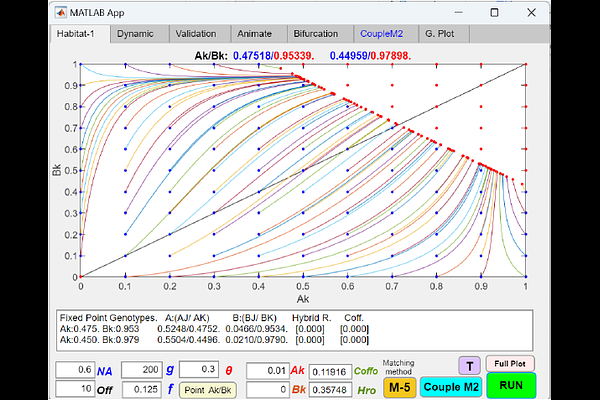Coupling of habitat-preference barriers leads to reproductive isolation in sympatric speciation

Coupling of habitat-preference barriers leads to reproductive isolation in sympatric speciation
Sultana, Z.; Heyda, C.; How, K.; Lin, J.
AbstractHabitat preference is a widely recognized mechanism of reproductive isolation, yet its role in initiating premating barriers and coupling with other barrier mechanisms to establish robust and irreversible reproductive isolation (RI) in sympatric speciation remains unclear. In this study, we developed mathematical models and computer applications to investigate one- and two-allele models of habitat-preference barriers in sympatric populations under disruptive ecological selection. We examined two spatial arrangements: an open-space model inspired by sympatric cichlid fishes that meet in open water with niche habitats that are small relative to lake size, and a no-open-space model inspired by sympatric hawthorn and apple maggot flies that move directly between trees without lingering in midair. Next, we examined coupling between habitat-preference barriers and a two-allele mating-bias barrier developed in a prior study to analyze how their invasion and coupling dynamics could lead to stronger RI. Our findings confirm that habitat preference is an independent mechanism capable of establishing initial premating barriers in sympatric speciation. Moreover, it can couple with additional barriers, such as those based on mating-trait discrimination, to enhance overall RI. Because habitat preference is an adaptive barrier mechanism, its invasion and coupling are driven by selection pressures arising from maladaptive hybrid loss, and it is readily reversed when disruptive ecological selection weakens. The one-allele model is easier to evolve than the two-allele model because it is immune to recombination by gene flow. Habitat-preference barriers can facilitate the emergence of mating-bias barriers. Open-space systems provide fewer opportunities for inter-niche encounters and tend to result in stronger RI compared to no-open-space systems. By elucidating the habitat-preference mechanism, our study reinforces the important role of habitat-preference barriers in sympatric speciation. It also provides insights into a wide range of premating isolating mechanisms--temporal, behavioral, and mechanical--that function similarly by reducing mating encounters.